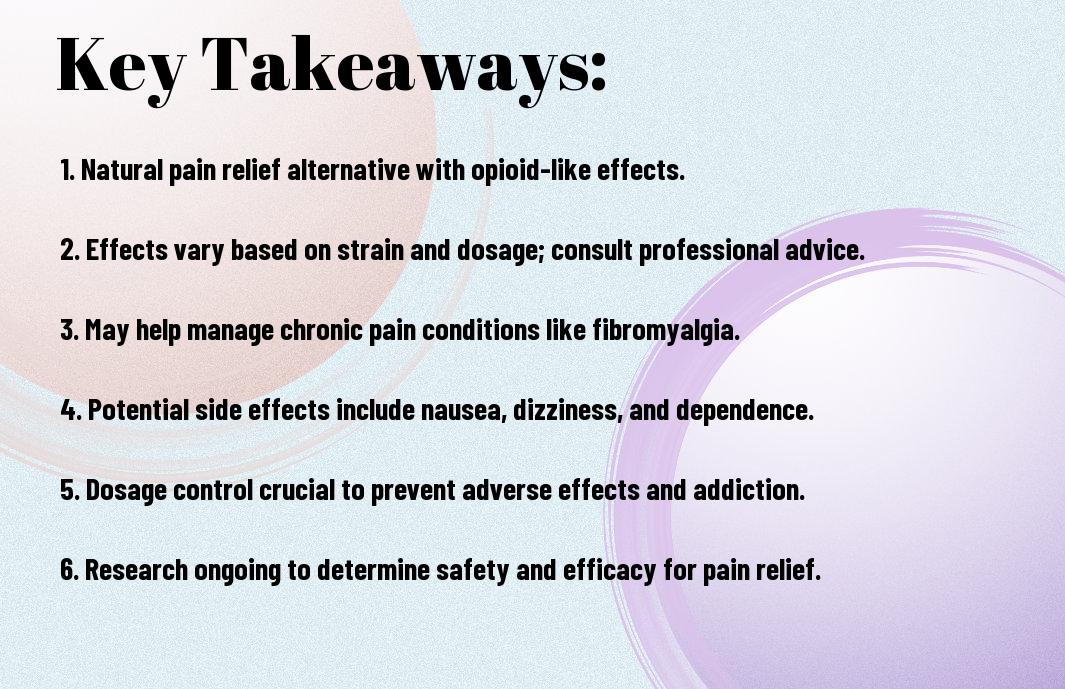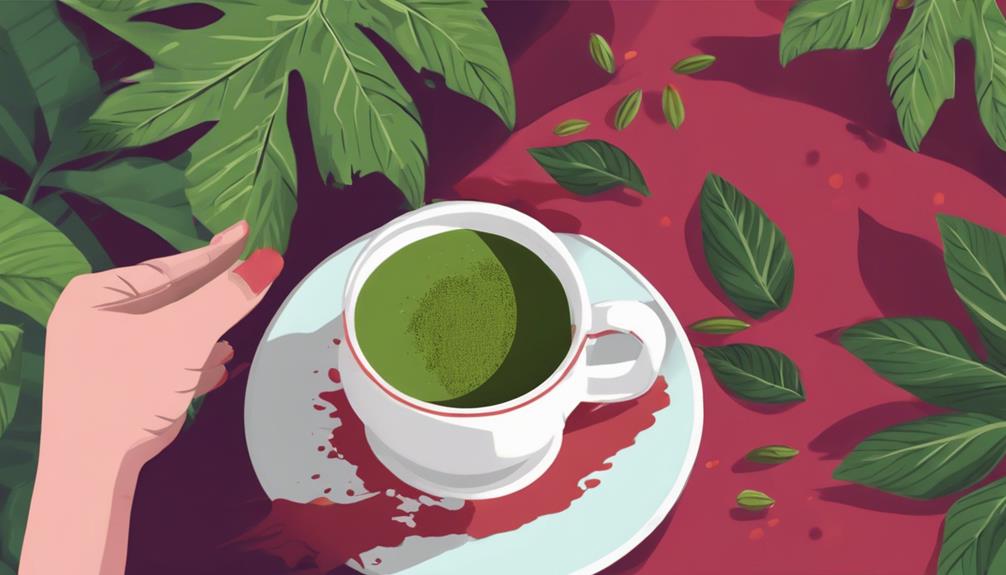Deprecated: mb_convert_encoding(): Handling HTML entities via mbstring is deprecated; use htmlspecialchars, htmlentities, or mb_encode_numericentity/mb_decode_numericentity instead in /home/users/kratomfiles/www/kratomfiles.com/wp-content/plugins/quick-adsense-reloaded/includes/template-functions.php on line 3552
Chronic pain, a relentless adversary for many, has led to a quest for safe and effective solutions. Kratom, a natural herb with analgesic properties, is gaining attention as an alternative for managing long-term pain. In this informative post, we investigate into the potential benefits and risks of using kratom for chronic pain relief, shedding light on its controversial status in the medical world. Let’s explore how this ancient remedy is being considered in modern pain management practices.

Key Takeaways:
- Kratom may help relieve chronic pain due to its natural opioid-like properties.
- Caution is advised when using kratom for chronic pain, as it can lead to dependence and withdrawal symptoms.
- Consulting a medical professional before using kratom for chronic pain is crucial to ensure safe usage and monitoring of its effects.

The Prevalence of Chronic Pain
A Kratom Primer for Pain-Treating Clinicians can shed light on the potential benefits of this herb for managing chronic pain. Chronic pain is a common condition that affects millions of people worldwide, significantly impacting their quality of life. Individuals suffering from chronic pain often seek alternative therapies, such as kratom, to alleviate their symptoms and improve their daily functioning.
Defining Chronic Pain
An understanding of chronic pain is crucial for implementing effective treatment strategies. Chronic pain is characterized by persistent pain that lasts for weeks, months, or even years. It can stem from various sources, including injuries, medical conditions, or unknown causes. Unlike acute pain, which typically serves as a warning signal for the body to address an immediate threat, chronic pain persists long after the initial injury has healed.
Statistics on Chronic Pain Sufferers
To grasp the impact of chronic pain, it’s important to consider the prevalence of this condition. Studies indicate that over 50 million adults in the United States alone suffer from chronic pain. This staggering number underlines the urgent need for accessible and effective pain management solutions to improve the lives of individuals battling this debilitating condition.
The Rise of Kratom
It seems that kratom has come into the spotlight in recent years as a potential solution for chronic pain. This natural herb, native to Southeast Asia, has gained popularity for its reported pain-relieving properties. But what exactly is kratom, and how has its use evolved over time?
What is Kratom?
Rising from the leaves of the Mitragyna speciosa tree, kratom is a tropical plant that has been used for centuries in traditional medicine. The active compounds in kratom, called alkaloids, interact with the opioid receptors in the brain, producing pain relief and a sense of well-being. Kratom is often consumed by chewing the leaves, brewing them into tea, or in the form of capsules or powders.
History of Kratom Use
Rising from its origins in Southeast Asia, kratom has a long history of use in countries like Thailand, Malaysia, and Indonesia. In the past, laborers and farmers would chew on kratom leaves to combat fatigue and alleviate pain. However, kratom has faced controversy and legal restrictions due to concerns about its potential for abuse and addiction.
A deeper investigate the history of kratom use reveals a mixed legacy. While kratom has been treasured for its pain-relieving properties and energy-boosting effects, it has also been linked to cases of dependency and adverse reactions, highlighting the importance of understanding its risks and benefits.
How Kratom Works for Chronic Pain
The Science Behind Kratom’s Analgesic Properties
Many people turn to kratom to alleviate chronic pain due to its potent analgesic properties. Kratom contains active compounds that interact with the body’s opioid receptors, providing pain relief similar to opioids but with less risk of respiratory depression. This natural remedy has gained popularity among individuals seeking alternative pain management strategies.
Binding to Opioid Receptors
Analgesic effects of kratom are primarily attributed to its ability to bind to mu-opioid receptors in the brain, just like prescription opioids. This interaction triggers a cascade of events that result in pain relief and a sense of well-being. It’s important to note that while kratom acts on opioid receptors, its mechanism of action is different from traditional opioids, which could potentially reduce the risk of dependence and addiction.
In recent years, research has shed light on the complex ways in which kratoms compounds modulate pain perception and inflammation in the body, offering promising insights into its therapeutic potential for chronic pain management.
Reducing Inflammation and Pain Perception
On top of interacting with opioid receptors, kratom has also been found to possess anti-inflammatory properties that can help reduce pain and swelling. By inhibiting inflammatory pathways and modulating pain signals, kratom may offer a multi-faceted approach to managing chronic pain conditions. These dual actions make kratom a versatile option for individuals seeking natural remedies for pain relief without the risk of serious side effects associated with pharmaceutical medications.
To fully understand how kratom can help alleviate chronic pain, it’s necessary to explore its diverse mechanisms of action and their implications for pain management strategies.
Benefits of Using Kratom for Chronic Pain
Effective Pain Relief
Despite the ongoing debate around kratom, many individuals with chronic pain find relief using this natural supplement. Any anecdotal evidence suggests that kratom can provide effective pain relief, especially for conditions like arthritis, fibromyalgia, and lower back pain. Some users report that kratom helps them manage their pain levels and improves their overall quality of life.
| Benefits | Details |
| Effective Pain Relief | Can help manage chronic pain conditions |
| Improved Quality of Life | Users report better pain management and physical function |
Fewer Side Effects Compared to Opioids
Relief from chronic pain often comes with a price when using traditional opioids, as they can lead to a range of side effects, including addiction and respiratory depression. In contrast, kratom is touted for having fewer side effects, making it a potentially safer alternative for those seeking pain management without the risks associated with opioids.
| Side Effects Comparison | Kratom |
| Nausea | Less common with kratom |
| Respiratory Depression | Not typically associated with kratom use |
Natural and Non-Addictive
With kratom, chronic pain sufferers have access to a natural alternative that is both effective and non-addictive. Any concerns about dependence or addiction are often outweighed by the relief and benefits that kratom offers. Additionally, kratom is derived from the leaves of the Mitragyna speciosa tree, making it a plant-based remedy that has been used for centuries in traditional medicine.
NonAddictive – Kratom’s non-addictive properties make it a desirable option for those wary of the addictive nature of opioids. It provides a way to manage pain without the risks of developing a dependency on the medication.
Different Strains of Kratom for Chronic Pain
Unlike traditional pain medications, kratom offers a variety of strains that cater to different needs when it comes to chronic pain management. Each strain has its unique properties that make them suitable for various purposes.
Bali Kratom for Relaxation and Pain Relief
Strains of Bali kratom are well-known for their relaxing and pain-relieving effects. This strain is particularly popular among individuals seeking relief from chronic pain without feeling sedated. Bali kratom is also praised for its mood-boosting and anxiolytic properties, making it a versatile option for those looking to unwind while managing their pain.
Maeng Da Kratom for Energy and Pain Management
Bali for its potent properties, Maeng Da kratom is a favored strain for individuals seeking a natural solution for chronic pain while needing an extra boost of energy. This strain is often described as an excellent stimulant that can also help in improving focus and concentration. Maeng Da kratom is a go-to option for those looking to increase their productivity levels while dealing with pain.
Relief Individuals battling chronic pain who also require a boost in energy levels often find Maeng Da kratom particularly beneficial. Its dual action in providing pain relief while offering increased energy is what sets it apart from other strains.
Indo Kratom for Mood Enhancement and Pain Reduction
Chronic Indo kratom stands out for its ability to enhance mood while effectively reducing pain levels. This strain is favored by individuals looking for a well-rounded solution that addresses both emotional well-being and physical discomfort. Indo kratom is renowned for its calming and pain-relieving effects, making it a popular choice for chronic pain sufferers.
To Those seeking a holistic approach to chronic pain management often turn to Indo kratom for its unique blend of mood-enhancing and pain-reducing qualities. Its ability to provide relief on both fronts makes it a versatile option for those looking to improve their overall well-being while dealing with chronic pain.
Are There Different Types of Kratom Products Specifically for Chronic Pain Relief?
Yes, there are different types of kratom products specifically for chronic pain relief. Kratom products pain relief have been known to help manage chronic pain conditions like arthritis, migraine, and fibromyalgia. Some popular kratom products for pain relief include Maeng Da, Bali, and Borneo strains.
Can Kratom Be Used for Chronic Pain Management as Well as Opiate Withdrawal?
Kratom is increasingly being explored as a natural remedy for withdrawal from opiates. Some users claim it can help manage chronic pain and ease symptoms of opiate withdrawal. However, there is limited research on its safety and efficacy. It’s important to consult a healthcare professional before using kratom for these purposes.
Potential Risks and Interactions
Now, let’s research into the potential risks and interactions associated with using kratom for chronic pain management.
Kratom Interactions with Medications
Medications that interact with kratom can lead to serious health risks. It’s crucial to consult with a healthcare professional before combining kratom with any prescription drugs. Some substances, such as opioids, may have dangerous interactions with kratom, potentially leading to respiratory depression or overdose.
Possible Side Effects and Contraindications
On the flip side, kratom may cause certain side effects and have contraindications for some individuals. Common side effects include nausea, constipation, and dizziness, especially at higher doses. Additionally, individuals with pre-existing conditions such as liver disease should be cautious when using kratom, as it may exacerbate these conditions.
With that in mind, it’s imperative to practice responsible kratom use to minimize potential risks and ensure a safe experience.
The Importance of Responsible Kratom Use
Medications that interact with kratom can have varying effects on the body, emphasizing the importance of responsible use. It’s crucial to start with low doses and gradually increase as needed, always being mindful of potential interactions with other substances. Plus, it’s advisable to source kratom from reputable suppliers to ensure product quality and avoid contamination.
Final Words
Considering all points, it is evident that kratom can be a beneficial option for individuals dealing with chronic pain. While there are risks and potential drawbacks to its use, when consumed responsibly and in moderation, kratom has the potential to provide relief for those who have not found success with traditional pain management methods. As with any supplement or alternative treatment, it is crucial to consult with a healthcare provider before incorporating kratom into your pain management regimen.
FAQ
Q: What is kratom and how is it related to chronic pain?
A: Kratom is a tropical evergreen tree native to Southeast Asia. It has gained popularity for its potential use in managing chronic pain due to its analgesic properties.
Q: How does kratom work to alleviate chronic pain?
A: Kratom contains alkaloids that interact with opioid receptors in the brain, resulting in pain relief similar to opioids but with a lower risk of respiratory depression.
Q: Is kratom safe for managing chronic pain?
A: While some people find relief from chronic pain with kratom, it’s important to use it responsibly and under medical supervision to avoid dependency and adverse effects.
Q: What are the potential side effects of using kratom for chronic pain?
A: Side effects of kratom may include nausea, constipation, dizziness, and in high doses, it can lead to dependence, addiction, and withdrawal symptoms.
Q: How should one approach using kratom for chronic pain management?
A: It’s crucial to consult with a healthcare provider before using kratom for chronic pain. They can provide guidance on dosage, potential interactions with medications, and monitoring for any adverse effects.










